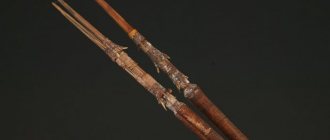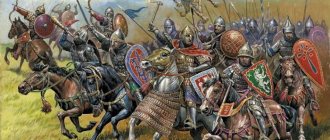Egypt for a long time remained one of the greatest states of antiquity. Starting from the period of the Old Kingdom (2778-2220 BC), during the era of the pyramid-building kings, Egypt waged constant military operations against its neighbors, both offensive and defensive. Of course, in such “practical” conditions the strongest army in the region was born - the fearless warriors of the pharaohs.
Ancient Kingdom Equipment
A simple warrior armed himself with a bow and arrows. For hand-to-hand combat, they used maces and copper battle axes; those who were poorer did not hesitate to use stone daggers and spears with stone tips. At that time, Egypt had only one branch of ground forces, infantry. However, even then these were not just scattered detachments - the commanders knew how to form soldiers in ranks, and when storming fortresses they skillfully used assault ladders.
Clear structure
Unlike many other nationalities of that time, the Egyptians knew how and loved the clear organization of any business. The army of Egypt during the Middle Kingdom was divided into detachments of 2,3 and 10 thousand soldiers. Recruitment into the army took place on a voluntary basis, which was also unusual - all of Egypt’s neighbors generally used the services of mercenaries, who were bought at the right time.
Interesting facts about the army of Ancient Egypt
The soldiers of the Egyptian army were highly respected. They received spoils from battles, as well as a piece of land when they retired. Sometimes little boys were enlisted in the army at the age of 5. However, they didn't actually start fighting until they were 20 years old. Army units were often named after gods. The Egyptians often hired foreign mercenaries to fight for them, especially in battles that took place far from Egyptian soil.
See also:
- The ancient Egyptian god Apis: how he was depicted, what he was responsible for, what he did
- Rich man's house in Ancient Rome: mansion plan, courtyard, main room
Middle Kingdom Specialization
The armament of Egyptian warriors was constantly evolving. Already during the Middle Kingdom, new, more advanced bows appeared with an arrow range of up to 180 meters. The organization of the entire army also changed, divided into detachments of spearmen and archers. All units had a certain number of soldiers: 6, 40, 60, 100, 400 and 600 soldiers.
Regular army and chariots
At some point, the Egyptian army turned into a regular conscript army. The youth had to serve a certain term, after which people returned to peaceful life. A significant strengthening of the army occurred through the use of mercenaries - most often the Egyptians used Nubians. In the middle of the 17th century BC, power in Lower Egypt was seized by the Hyksos, from whom the Egyptians learned about war chariots.
How warriors lived in ancient Egypt
The life of an Egyptian soldier was hard, they lived in barracks and were subject to the strict rules of the barracks commander. Usually this position was occupied by an old warrior who had earned fame and respect in numerous battles.
Warriors trained very hard to maintain their strength and endurance. They also trained with various types of weapons. If some soldiers were good with a bow, then they became archers. The army was often used for tasks other than fighting.
After all, if the pharaoh was obliged to feed all these people, he must have derived some benefit from their existence in times of peace.
The army worked in the fields during sowing and harvesting. They also worked as laborers on many construction projects such as palaces, temples and pyramids.
New Kingdom Equipment
The organization of the Egyptian army reached its peak during the New Kingdom. The army became not only regular, but also caste; the weapons of the warriors (straight and sickle-shaped swords were in use) were supplied by the state. Previously, a warrior was protected only by a helmet and a wooden shield, but now the majority could boast of reliable leather armor with sewn bronze plates. The infantry had already begun to give way to war chariots: the Egyptians realized that it was almost impossible to resist this force.
Ancient Egypt: clothes of pharaohs, warriors, peasants
And again we begin the illustrative series with a picture from a textbook on the history of the Ancient World for the 5th grade of an old Soviet school. As you can see, the clothes on the Egyptians in general are not drawn very clearly. Something white, similar to a skirt, and not at all like what you will later see on authentic Egyptian frescoes, but children don’t need anything else. And the appearance of the temple, and the nature of the field work - everything is conveyed very carefully. I don’t even dare to guess how much an artist would charge today for such an illustration, and most importantly, what we would get in the end...
...and he will put off the linen garment which he put on when he entered the sanctuary... Leviticus 16:23
Dress culture.
Today we will get acquainted with the clothes, jewelry and hairstyles of the ancient Egyptians - people who created a unique civilization and paid great attention to their appearance. However, first it would be appropriate to give a periodization of ancient Egyptian history, so that later, in the text of the article itself, we will not be distracted by this.
Let's start with the fact that people appeared on the territory of Egypt more than 40 thousand years ago, but the first state formation, Predynastic Ancient Egypt, appeared there about five thousand years BC. This was followed by the era of the Early Kingdom, followed by the Old Kingdom, the time of the pharaohs who built the pyramids, the First Transitional Period (“the Age of Troubles”), the Middle Kingdom and the Second Transitional Period, and finally the New Kingdom and the Third Transitional Period. Its further history in connection with our topic is uninteresting, because the Assyrians, Persians, then Alexander the Great, and the Romans came to Egypt, and the original Egyptian fashions underwent very strong foreign influence.
It is clear that the nature of clothing was related to the climatic conditions of the places of residence. And, of course, the Paleolithic hunter in fur clothes was different from exactly the same hunter who hunted in the Nile Delta. Archaeological Museum, Bonn
And it should be noted that during all these three long eras and intermediate periods, the clothing of peasants and common people was very simple and usually consisted of only one linen apron. During field work, he was often filmed. It was believed that any clothing restricts movement, and therefore many preferred to work in what their mother gave birth to.
Image on the wall of one of the corridors of the dungeon of the Pyramid of Djoser
Noble people in the era of the Old Kingdom tied aprons on their hips with wide sashes. In addition, even then wide collars made of a variety of materials were in fashion: from multi-colored glass, semi-precious and precious stones to gold.
Husband and wife, and the wife's name is Senet. First transition period. Cairo Museum
Not only men, but also women shaved the hair on their heads, and wigs were put on their shaved heads - short, curled and long with straight strands and parting. A wig made of twisted sheep's wool was also a headdress and... a helmet for the warrior, who again wore only an ordinary apron and a shield covered with cow skin with the hair facing out.
Human figurine. Middle Kingdom. Cairo Museum
Over time, however, tastes became more sophisticated, and people's needs became more extensive. And by the New Kingdom, not even a trace remained of the former primitive simplicity of men's clothing. The apron was replaced by an elegant suit, vaguely reminiscent of a long skirt with small folds.
The oldest remains of linen fabric. Cairo Museum
And this is also a rarity - the remains of fabric from the Copts, the heirs of the ancient Egyptians. Cairo Museum
From the images that have come down to us, we can even trace changes in the fashion and tastes of the Egyptians. Of course, all of them belonged only to the wealthy segments of the population, and the poor were content with the simplest clothes and did not pursue fashion.
Thus, during the time of Queen Hatshepsut, a short but wide shirt with a sash came into use. It became customary to cover the upper part of the body with it, although until then the Egyptians went naked to the waist. Under Akhenaten, long pleated aprons came into fashion. They are worn in two pairs at once, with the upper one being shorter so that the larger folds of the lower one peek out from under it. The ends of the belt were supposed to hang down in the form of a long bow.
This fresco shows almost all types of clothing of the New Kingdom. Cairo Museum
Subsequently, men's attire became more and more diverse, although they were still based on the same simple apron. Moreover, this clothing was very democratic. After all, the last of the peasants and the first of the people, the son of the deity - the pharaoh, wore an apron! But, combining its length and shape, sometimes making it smooth, sometimes gathering folds, sometimes slightly covering the hips, sometimes tightly fitting the legs, sometimes very narrow, sometimes so wide that it could be wrapped around the body three times, Egyptian tailors modified this very ordinary apron to unrecognizability. So over time, it began to resemble a fashionable ladies' dress of our century, rather than a linen apron from the era of the Old Kingdom.
In Egypt, musicians and dancers had their own professional clothes. Reproduction from 1910 from one of the ancient Egyptian frescoes. Cairo Museum
It is interesting to note that the men's clothing of the ancient Egyptians was much more varied and sophisticated than the women's. One could even say that it was men fashionistas who set the tone in clothing, and not women. In all images, from the most ancient to those dating back to the 18th dynasty, we see women in the same, very simple, tight-fitting linen dresses. Fashion designers even argue whether they were cut or knitted. In any case, the shirt cut of women’s dresses was the main one in Egypt; Egyptian women did not know any fluffy skirts, much less crinolines.
For Egyptian ladies, the wig was very important. Still from the Polish film “Pharaoh”, 1963)
But noble ladies wore long, fluffy wigs, curled in curls made of horsehair or sheep's wool, and adorned themselves with expensive necklaces and bracelets, rings and earrings.
And one more shot from the same film. The rake-pharaoh Ramses XIII abandoned his mistress Kama and decided to take care of the bride of his close associate Thutmose named Hebron... Pay attention to her necklace. Both women and men wore such jewelry in Egypt.
The favorite color of Egyptian women and men was white, but there were dresses in red, yellow and green. The monotony of cut and style was partially offset by the intricate straps that supported the dress. Sometimes they ran parallel, across both shoulders, sometimes they crossed or diverged at an angle. Fashionistas decorated their dresses with patterns in the form of vertical or horizontal stripes. The cry of fashion was the ornament made in the form of colorful bird feathers or zigzags.
Here is one of them - a collar necklace made of lapis lazuli. Metropolitan Museum of Art, New York
"Collar" of the Middle Kingdom era. Cairo Museum
"Collar" of the Third Transition Period. Cairo Museum
The era of the 18th dynasty, when the enormous wealth of the conquered countries poured into Egypt, finally put an end to the simplicity and monotony of women's attire. Noble Egyptian ladies became addicted to magnificent dresses, and fashion became, as it is today, very fleeting, changeable and capricious. In countless images of this era, we see Egyptian fashionistas in beautiful, floor-length dresses, with the right shoulder invariably exposed and the left one covered.
This was the time when there was a sharp distinction between the cut of dresses of noble people and the common people. Of course, long and fluffy clothes that hampered movement were unsuitable for work, and such an outfit required several times more material than an ordinary dress.
Regular sandals. New kingdom. Cairo Museum
The shoes were relatively simple. Both among peasants and pharaohs. Both men and women wore sandals, which consisted of a leather sole and several straps encircling the foot. Subsequently, sandals with upturned toes came into fashion.
Incense spoon. Cairo Museum
The invariable accessory of every rich Egyptian woman were elegant boxes for blush, vessels with ointments for rubbing, hand mirrors, bottles of perfume, and spoons for cosmetics. Egyptian jewelers gave all these products elegant shapes and decorated them with images of people, animals and birds.
The protective clothing of the warriors of the Ancient, Middle and New Kingdoms was very primitive, except that only the pharaohs or the most famous commanders wore metal scale armor
The custom of lining the eyes and painting the eyelids with greasy paint made from grated malachite also goes back to ancient times. In Egypt, both men and women did this, and this had a certain meaning: the sticky, dark paint protected the eyes from dust and partially from the too bright African sun.
"The beautiful one is coming." The legendary bust of Queen Nefertiti from the New Museum in Berlin
The way the Egyptians sometimes protected themselves from overheating was original. They attached a small fat cone to the head, made of a special thick and aromatic composition. As it melted from the sun, fragrant streams flowed from the head, which pleasantly refreshed the body.
To be continued…
War chariots
In the middle of the New Kingdom era, war chariots took on leading roles. Each death machine was equipped with a driver and a shooter, and foreigners were not allowed to drive the war chariot. The warriors were forced to buy a very expensive chariot with their own money, but this was considered more of a privilege - at that time the army finally became caste.










